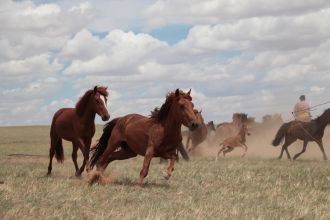Media release
From:
Genetics: Honing in on the homeland of horses *IMAGES*
recently updated!
Please note this is a proof and the final version of the paper will be uploaded when it is available. We do ask that you please check back against the final version of the paper once this is available.
Related documents (2)Related images (6)
The modern domestic horse may have originated in the Western Eurasian steppe more than 4,200 years ago, suggests a Nature paper. The study identifies two candidate genomic regions associated with desirable adaptations for horseback riding in modern horses, the selection of which may have aided the spread of horses from the Western Eurasian steppe.
Horse domestication transformed long-range mobility and warfare, but the genetic and geographic origins of modern domestic horses remain unknown. Currently, there is evidence for a domestic horse lineage associated with the Botai settlement in Central Asia around 3500 BC, but these ancient horses are known not to be related to modern domestic horses.
To pinpoint the homeland of the modern domestic horse, Ludovic Orlando and colleagues gathered remains from 273 ancient horses from locations previously considered to be possible regions of horse domestication, including Iberia, Anatolia and the steppes of Western Eurasia and Central Asia. Through the analysis of DNA isolated from these ancient remains, the authors identified a domestication centre in the lower Volga-Don region, now part of Russia, from which horses spread across the world 4,200 years ago. The authors further linked critical movement and behavioural adaptations in horses — including endurance, weight-bearing ability, docility and stress resilience — that are associated with horseback riding to the positive selection of two genes, GSDMC and ZFPM1.
The authors suggest that horseback riding and the use of spoke-wheeled war chariots supported the spread of the newly domesticated horses, and within around 500 years of the initial domestication, this new horse breed replaced all other previous populations across Eurasia.
Multimedia







 Australia; International; SA; WA
Australia; International; SA; WA



